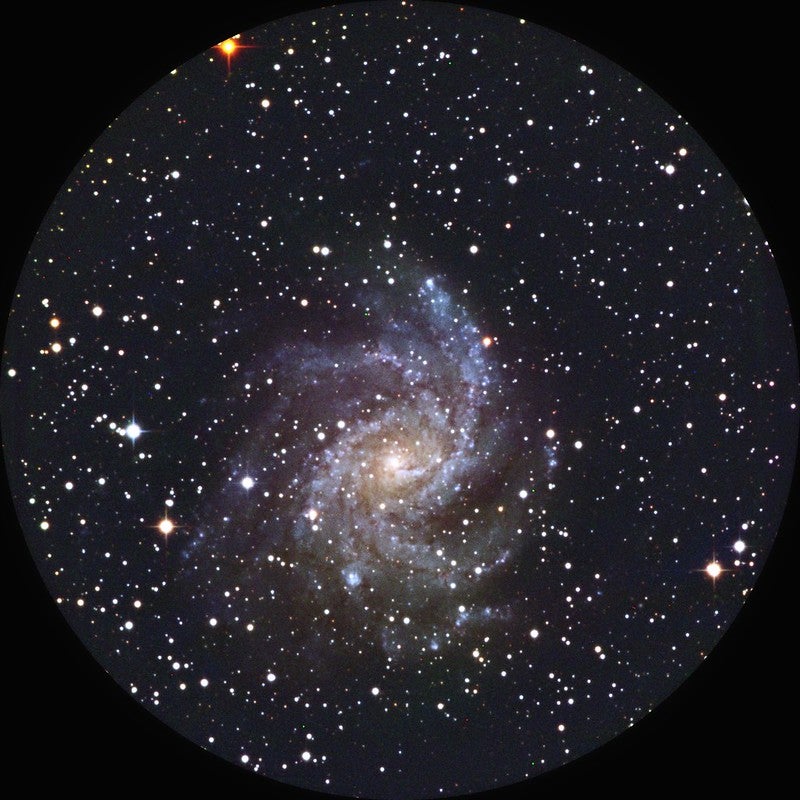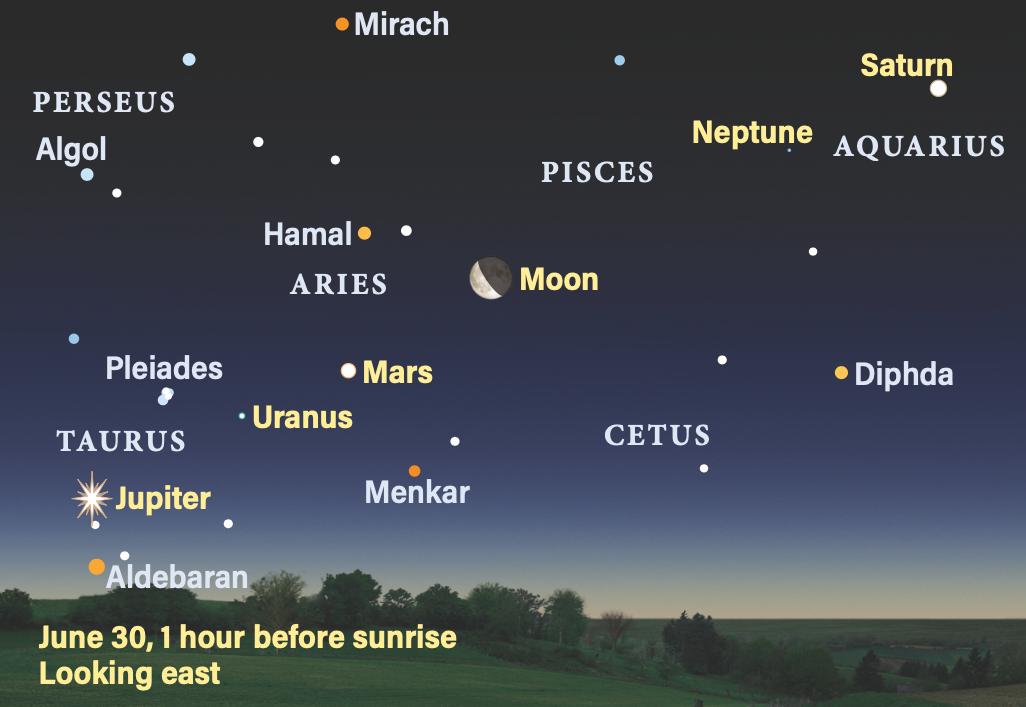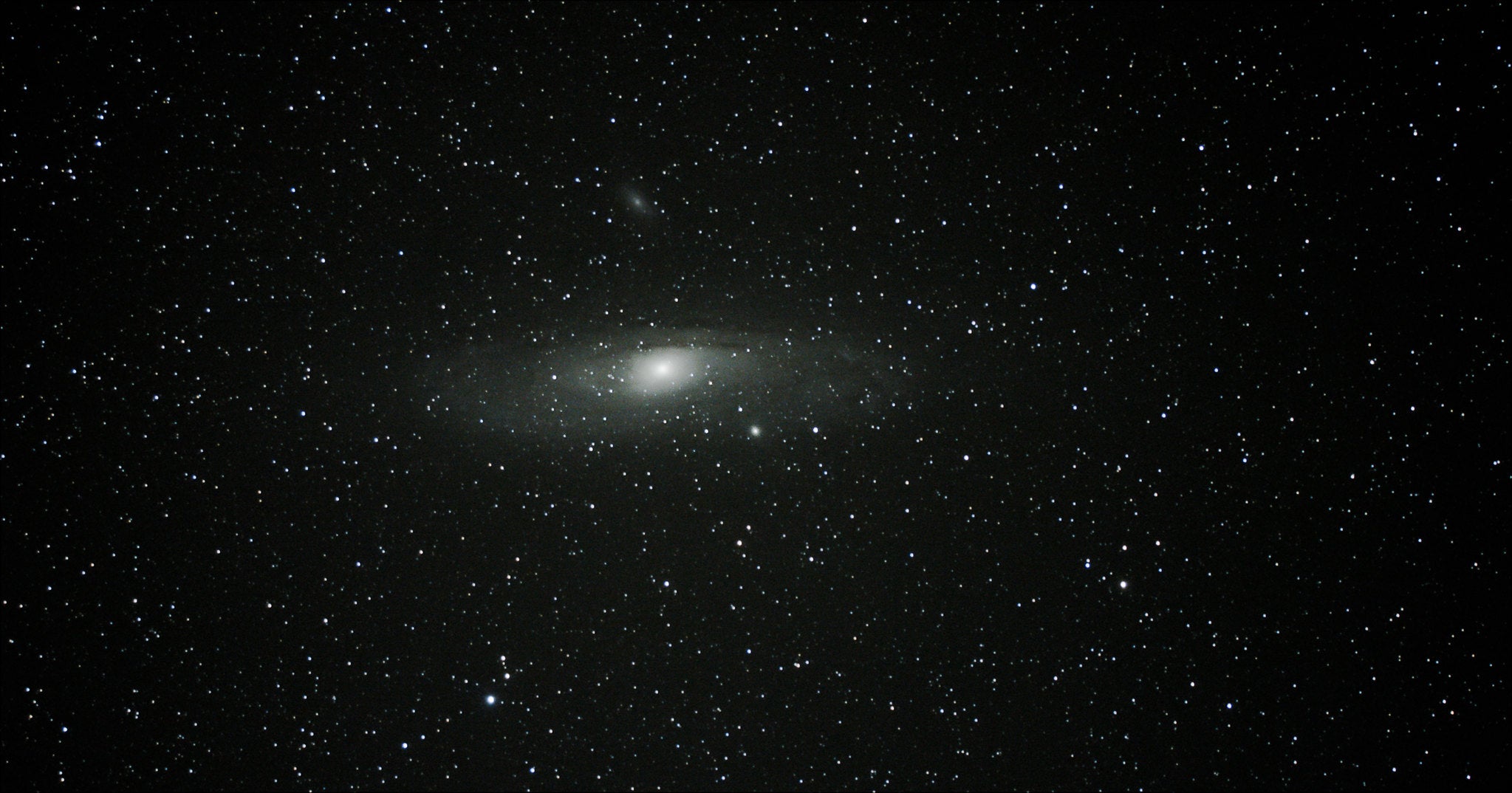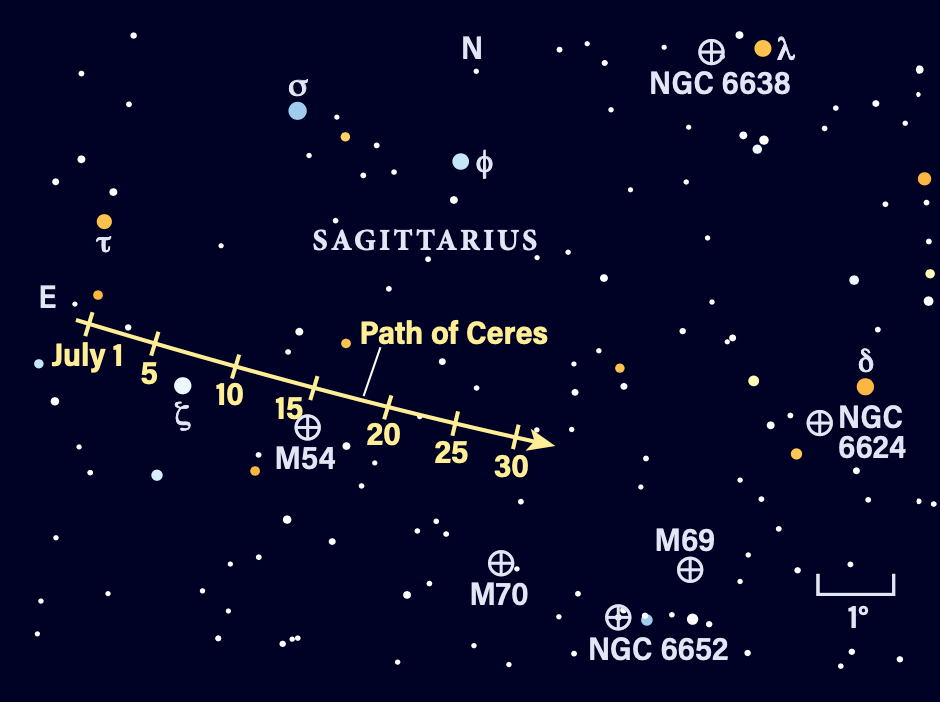
Friday, June 28
The Moon passes 0.3° north of Neptune at 5 A.M. EDT. Roughly half a day later, at 5:53 P.M. EDT, the Moon reaches Last Quarter as it slowly wanes from Full to New.
We’ll catch up with Neptune in the morning sky later this week. Tonight, with no Moon to interfere, let’s visit the constellation Cygnus, high in the east a few hours after sunset, to check out the North America Nebula, also cataloged as NGC 7000.
This stunning nebula spans some 120′ (or 2°) and lies just over 3° east of Cygnus’ alpha star, magnitude 1.3 Deneb. It houses three separate open clusters — NGC 6989, NGC 6996, and NGC 6997 — which appear to fill the region with stars. Although the nebula itself can be a bit hard to see, a UHC filter can help. Just to its west lies another famous nebula, the Pelican Nebula (IC 5070), separated from NGC 7000’s “east coast” by a dark swath of dust.
For a serious challenge, wait until the region is high in the sky and, if your viewing location is dark with no light pollution, try to spot the North America Nebula with the naked eye! If you can pick it up, you’ll see a faint smudge near Deneb that is some three or four times the size of the Full Moon in the sky.
Sunrise: 5:34 A.M.
Sunset: 8:33 P.M.
Moonrise: 12:34 A.M.
Moonset: 12:56 P.M.
Moon Phase: Waning gibbous (52%)
*Times for sunrise, sunset, moonrise, and moonset are given in local time from 40° N 90° W. The Moon’s illumination is given at 12 P.M. local time from the same location.
Saturday, June 29
Mercury passes 5° due south of the bright star Pollux in Gemini at 6 A.M. EDT. You can catch the pair in the evening sky just after sunset, though you’ll need to be quick — 40 minutes after sunset, Mercury is just 4.5° high, while Pollux is just starting to pop out against the darkening sky to the planet’s upper right.
Mercury is a bright magnitude –0.8, compared with Pollux at magnitude 1.2. To the right of Pollux, if you’re particularly sharp-eyed, you might also spot magnitude 1.6 Castor, Gemini’s alpha star (although it is brighter, Pollux is cataloged as Beta [β] Geminorum).
Through a telescope, Mercury’s disk shows off its gibbous phase, some 80 percent illuminated. If you watch it over the next few days, you’ll notice it waning night by night. The solar system’s smallest planet has an apparent diameter tonight of 6″, which will slowly grow even as its phase wanes in the coming days.
Sunrise: 5:35 A.M.
Sunset: 8:33 P.M.
Moonrise: 12:58 A.M.
Moonset: 2:08 P.M.
Moon Phase: Waning crescent (41%)

Sunday, June 30
Saturn reaches its stationary point against the background stars of Aquarius at 5 P.M. EDT. It’s not visible in the evening but instead stands high in the pre-dawn sky in the lineup of planets currently visible before sunrise.
Around 3:30 A.M. local daylight time, Saturn is already more than 30° high. It’s located about 2° east of Phi (ϕ) Aquarii, though at 1st magnitude, Saturn far outshines the 4th-magnitude star.
Through a telescope, Saturn’s disk stretches a healthy 18″; its rings span a little more than twice that, reaching some 40″ from end to end. The planet is surrounded by several of its moons, and many U.S. observers will get the chance to watch the largest and brightest moon, Titan, transit the southern portion of the disk this morning. The transit starts around 3:50 A.M. EDT as the moon slips in front of the world, moving east to west. Titan takes more than four hours to make its journey, finally moving off the disk shortly after 5 A.M. PDT, after sunrise in all other U.S. time zones.
The smaller moon Enceladus also makes a transit this morning, led by its tiny shadow. Enceladus’ transit begins around sunrise in the Mountain time zone (5:30 A.M. MDT, or 4:30 A.M. PDT), so only those on the West Coast will really have a chance at seeing it — but only then if you have a large scope and are using video capture, as Enceladus is small and faint compared to the brighter disk of Saturn and may be impossible to visually pick out.
Sunrise: 5:35 A.M.
Sunset: 8:33 P.M.
Moonrise: 1:23 A.M.
Moonset: 3:21 P.M.
Moon Phase: Waning crescent (30%)

Monday, July 1
The Moon now passes 4° north of Mars at 2 P.M. EDT. Visible early this morning, the pair stands 30° high in the east an hour before sunrise, with the Moon appearing directly above magnitude 1 Mars. They are both in the constellation Aries, whose brightest star is a full magnitude fainter than Mars: magnitude 1 Hamal, which sits farther above the Moon.
Even higher in the sky, above Aries, is the constellation Andromeda. Earlier in the morning — say, two or three hours before sunrise — you might try to spot the Milky Way’s largest neighbor, the Andromeda Galaxy (M31). Glowing at magnitude 3.4, Andromeda is visible to the naked eye under clear, dark conditions. It’s located 1.3° west of magnitude 4.5 Nu (ν) Andromedae, making it relatively easy to find.
Lying just 2.5 million light-years away, Andromeda stretches a full 3° on the sky. Take your time enjoying it with any-sized telescope; larger apertures will show more detail, such as a brighter central core and wispy spiral arms. You may also spot its two brightest satellite galaxies, M32 and NGC 205, just ½° south and northwest of the galaxy’s center, respectively,
Sunrise: 5:35 A.M.
Sunset: 8:32 P.M.
Moonrise: 1:51 A.M.
Moonset: 4:35 P.M.
Moon Phase: Waning crescent (20%)
Tuesday, July 2
Continuing along the morning line of planets, the Moon passes 4° north of Uranus at 6 A.M. EDT. You can use our satellite to help you find the distant ice giant in the pre-dawn sky; an hour before sunrise, pull out your binoculars or any small scope and drop those 4° south of the Moon to land on Uranus, the penultimate planet from the Sun. Glowing at 6th magnitude, Uranus’ disk spans just 3″, thanks to its distance. It should appear as a “flat,” disklike star compared to the pinprick background stars around it.
Our solar system’s most distant planet and second ice giant, Neptune, is in Pisces. It is also approaching its stationary point. The world will stand motionless against the background stars this evening at 11 P.M. EDT, then slowly start to move retrograde (west) over the course of the month. This morning, you’ll find it about 5.5° southeast of Lambda (λ) Piscium, the magnitude 4.5 star that marks the southeasternmost point in the Circlet of Pisces. Neptune’s disk is even fainter than Uranus’ — magnitude 7.7 — and slightly smaller at 2″. It, too, should look like a flat star, perhaps with a faintly blue hue.
Although Neptune is more massive than Uranus, it is slightly smaller in terms of width. Uranus is roughly 4 times as wide as Earth, while Neptune is about 3 percent smaller than its fellow ice giant.
Sunrise: 5:36 A.M.
Sunset: 8:32 P.M.
Moonrise: 2:24 A.M.
Moonset: 5:50 P.M.
Moon Phase: Waning crescent (12%)
Wednesday, July 3
The Moon passes 5° north of Jupiter at 4 A.M. EDT. An hour before local sunrise, the planet is some 12° high in the east, standing above and just to the left of Aldebaran, the red giant star that marks the eye of Taurus the Bull. Jupiter remains a bright magnitude –2, making it easy to pick out in the early-morning sky even as dawn begins to approach. While you’re observing the region, test how long you can continue to see the Pleiades star cluster to Jupiter’s upper right; this gaggle of young stars is one of the most famous open clusters in our sky.
Meanwhile, the Moon itself may actually be a bit difficult to spot, as the thin waning crescent shows off only the slightest sliver of the western limb. With a telescope, see if you can identify the dark, round patch of the crater Grimaldi near the southwestern edge of our satellite. This feature is well known for its broad, dark, flat floor and is not technically a crater, but more of a basin where there is greater than average mass just beneath the surface.
In addition to the finer features on the Moon’s surface, see if there’s any earthshine today. Visible with the naked eye, this phenomenon casts the portion of the lunar surface in Earth’s shadow in a soft, gray light — this is reflected sunlight bouncing off Earth and illuminating the Moon.
Sunrise: 5:37 A.M.
Sunset: 8:32 P.M.
Moonrise: 3:04 A.M.
Moonset: 7:00 P.M.
Moon Phase: Waning crescent (6%)
Thursday, July 4
With a nearly New Moon in the sky, this July 4th is the perfect opportunity to check out the Fireworks Galaxy (NGC 6946). So named for its plethora of supernovae, NGC 6946 was discovered in 1798 and has hosted 10 known supernovae since 1917. The most recent was SN 2017eaw, which went off in 2017.
This roughly face-on spiral shines at 9th magnitude and spans about 11′ at its widest. It lies some 22 million light-years away and sits just at the border between the constellations Cepheus the King and Cygnus the Swan. You’ll find it some 50° high in the north two hours after sunset tonight in a great location for clear viewing, well out of the turbulent air near the horizon. The easiest way to locate NGC 6946 is to simply skim about 2° southwest of 3rd-magnitude Eta (η) Cephei. Note that because the galaxy is face-on, it’s a bit fainter and harder to detect under light-polluted skies. That’s because its light is more spread out due to the way we’re seeing it, rather than more concentrated as in edge-on galaxies.
As a bonus, the open star cluster NGC 6939, which shines about a magnitude brighter than the galaxy, is also nearby. You can find this young group of stars, which measures about 8′ across, just 40′ northwest of the Fireworks Galaxy.
Sunrise: 5:37 A.M.
Sunset: 8:32 P.M.
Moonrise: 3:53 A.M.
Moonset: 8:03 P.M.
Moon Phase: Waning crescent (2%)

Friday, July 5
Earth reaches aphelion, the farthest point in our nearly (but not-quite) circular orbit around the Sun, at 1 A.M. EDT. At that time, our planet will sit 94.5 million miles (151 million kilometers) from the Sun.
New Moon occurs this evening at 6:57 P.M. EDT, ensuring dark skies for those seeking to observe the dwarf planet 1 Ceres at opposition, a point it reaches tonight at 8 P.M. EDT.
Glowing at magnitude 7.3, Ceres is now in Sagittarius the Archer. Given the late summer sunset, you’ll need to wait until the sky grows dark, about two hours or so after the Sun disappears. Then look about 12° above the southeastern horizon to find the Teapot asterism of Sagittarius. Ceres sits near the left bottom corner of the pot, near magnitude 2.6 Zeta (ζ) Sagittarii, which marks the spot where the handle meets the base. From Zeta, simply slide 40′ north with binoculars or any small scope tonight and you’ll land right on Ceres.
The largest body in the main belt, Ceres spans some 600 miles (965 km) and was “upgraded” to dwarf planet in the same 2006 ruling that “demoted” Pluto. Ceres is now nearly 2 astronomical units from Earth; 1 astronomical unit, or AU, is the average Earth-Sun distance of 93 million miles (150 million km). It will continue moving southwestward through Sagittarius over the course of the month, sliding due west of Zeta in about a week’s time.
Sunrise: 5:38 A.M.
Sunset: 8:32 P.M.
Moonrise: 4:51 A.M.
Moonset: 8:56 P.M.
Moon Phase: New

Sky This Week is brought to you in part by Celestron.









